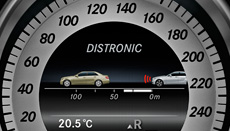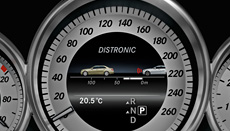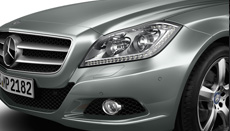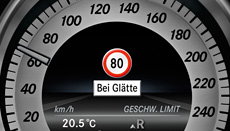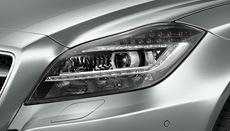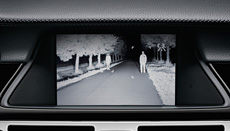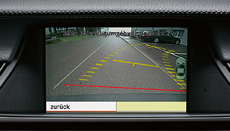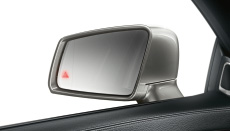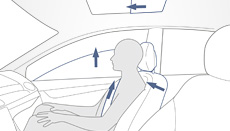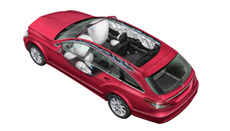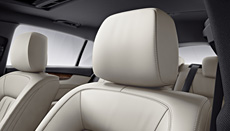

The Integral Safety Concept from Mercedes-Benz divides vehicle safety into four phases:
Virtually no other area inspires the Mercedes-Benz engineers to produce such consistently impressive results as much as research into new safety technologies. The first important safety milestone was reached back in the 1950s with the development of the passenger safety cell, invented by Béla Barényi. Today it is just one of many components of the Integral Safety Concept which edges Mercedes-Benz vehicles ever closer to our vision of accident-free driving.
Phase 1: safe driving
Most accidents start long before the actual collision: with a lapse in concentration, poor visibility or hazards which cannot be anticipated. That's why the Mercedes-Benz safety concept employs a range of measures to support safe driving in everyday operation and to help you bring critical situations under control.
The three-stage ESP® system aligns the suspension setting with driving style; it can reduce the danger of skidding and increase driving safety. Three control strategies are available at the push of a button. With the ESP® switch the driver can simply select from "ESP® ON", "ESP® Sport Handling Mode" and "ESP® OFF" modes. The system permanently compares current driving conditions with the driver's input. If the system identifies discrepancies, it applies braking to individual wheels in order to align driver requirements with driver input and to prevent skidding. The factors steering angle, climb angle, lateral acceleration and yaw rate are taken into account.
| |
DISTRONIC PLUS proximity control helps the driver to maintain a specified (timed) distance from the vehicle ahead when travelling at speeds of 0 to 200 km/h.
| |
Improved perceptual safety and reduced reaction times for drivers in following cars: the adaptive brake lights can make a significant contribution to preventing rear-end collisions by displaying emergency braking signs to vehicles. If the driver brakes or makes an emergency stop from a speed greater than 50 km/h, the brake lights flash in order to warn traffic behind. | |
Active Lane Keeping Assist continuously identifies lane markings on the road. Should the vehicle drift over a line or marking in an uncontrolled manner, Active Lane Keeping Assist can respond by initiating active independent braking. | |
The Active Blind Spot Assist uses radar and monitors the blind spot areas to the left, right and rear of the vehicle in the speed range 30 to 250 km/h. If a vehicle is detected within the monitored range, a warning symbol is displayed in the driver’s exterior mirror. Should the driver fail to notice the warning and start to change lane, the ESP® system can intervene.
| |
The anti-lock braking system (ABS) enhances driving safety, especially when braking for hazards. During hard braking the anti-lock braking system reduces wheel lock-up by modulating the braking pressure of the individual wheels. This ensures that the vehicle remains directionally stable and steerable while maintaining maximum braking power. In other words: ABS allows the driver to brake and steer simultaneously – allowing precise evasive manoeuvring – in order to avoid an accident. | |
The acceleration skid control (ASR) ensures that the wheels do not spin when accelerating. Especially when moving off on snow, ice and loose chippings, the acceleration skid control prevents individual wheels from spinning and the vehicle from sliding out to the side. The system uses speed sensors to monitor the slip characteristics of the wheels. If the system senses a wheel is starting to spin, the acceleration skid control corrects the wheel speed by braking and intervening in the engine management system, thus reducing the wheel slip and wheel spin. | |
The ATTENTION ASSIST function is particularly helpful on long journeys and when driving at night; the system warns the driver if it detects signs of failing attention and weariness. At speeds of between 80 and 180 km/h, ATTENTION ASSIST warns the driver visually and audibly as soon as it detects any signs of drowsiness or inattention.The background: Sensors analyse driving behaviour to detect any changes compared with the previously determined individual driver profile.
| |
The bi-xenon headlamps provide greater brightness, a larger range of light and wider illumination of the road surface than conventional headlamps. When the vehicle drives into a turn the system also activates a fog lamp, providing significantly better illumination for the area to the sides of the vehicle and improving safety. The integrated headlamp cleaning system is a simple and effective means of keeping the headlamps clean. Dynamic sensor-controlled headlamp range adjustment automatically compensates for any vehicle position changes caused by braking, accelerating, and vehicle load, avoiding the danger of dazzling oncoming drivers.
| |
Brake Assist (BAS) can protect against the risk of accidents. The system can recognise emergency braking from the speed at which the braking pedal is depressed and can automatically supply full braking power. The anti-lock braking system (ABS) then meters the braking power up to the slip threshold, which is how steering control is maintained. Once the driver releases the brake pedal, automatic brake boosting is immediately terminated. | |
The ADAPTIVE BRAKE system improves ride comfort and safety by helping to perform critical braking manoeuvres with the basic function of the ABS anti-lock braking system while convenience functions make it easier to master challenging driving situations.
| |
In critical situations, the Electronic Stability Program (ESP®) can help to stabilise the vehicle by applying a braking force to individual wheels and adjusting engine output. If ESP® detects a critical handling situation, brake pressure can be applied to one or more wheels as required. Should the system consider it necessary, it will also make an automatic adjustment to engine torque. In this way ESP® helps the driver to stabilise the vehicle (within the laws of physics) – particularly when cornering and during sudden evasive manoeuvres.
| |
With the help of the camera integrated in the windscreen, the Speed Limit Assist system can recognise traffic signs and display in the central display the speed limits they announce. This can reduce the danger of overlooking a speed limit, particularly on stretches of road with frequently changing traffic signs or along routes with road works. In order to verify the data retrieved via optical sensors and the subsequent display, the system compares the values registered with the digital road maps of the navigation system.
| |
The dynamic LED High Performance headlamps in conjunction with an LED daytime running lamp strip in the bumper cover are innovative aspects of the vehicle light array. The novel, unmistakable design of the LED high performance headlamps underscores the dynamism of the vehicle design, lending the front a particularly high value appeal. Used by Mercedes-Benz for the first time in the CLS, LED technology combines maximum beam output with a long service life and minimum energy consumption. Delivering a colour temperature of 5500 K, the LED high-performance headlamps are closer to the temperature of daylight than their bi-xenon counterparts and are very pleasant on the eyes. When driving at night, the "C" form of the LED position lamps makes the headlamps easily recognisable.
| |
Night View Assist PLUS improves visibility in the dark without making use of the main-beam headlamps. It also helps the driver's orientation, makes possible an earlier detection of persons and obstacles, and improves spatial orientation when driving on unknown roads. A camera scans the road illuminated by an anti-dazzle infrared headlamp and transmits a grey-scale image to the COMAND display. This helps the driver to recognise obstacles, poorly lit road users and the course of badly lit roads faster and more easily.
| |
The reversing camera offers convenience and added safety. Integrated in the boot lid, the camera transmits an image of the area behind the vehicle to the COMAND display. The camera image not only makes parking easier but also aids in manoeuvring on terrain with visibility limitations.
| |
Lane Keeping Assist can detect a traffic lane based on the road markings and, if the car is about to leave its lane unintentionally, warn the driver by making the steering wheel vibrate gently. If the indicator is operated beforehand or the steering wheel is consciously turned, the system assumes that the lane change is intentional and does not issue a warning. | |
Blind Spot Assist, meanwhile, uses two radar sensors in the rear bumper to monitor the blind spot at speeds above 30 km/h and can warn the driver against dangerous lane changes when the system detects another road user in the critical area to the right or left of the vehicle.
|
Phase 2: in critical situations
Mercedes-Benz stands for automotive safety. That's why our vehicles can support their passengers even in critical driving situations, so that every journey is as safe as it can possibly be.
In an emergency braking situation the BAS PLUS Brake Assist system can help shorten the stopping distance. BAS PLUS is coupled with the short-range radar of the DISTRONIC PLUS system. When it detects the risk of a rear-end collision, it alerts the driver with both a visual and an audible warning, calculating at the same time the brake pressure necessary to avoid the collision. This brake boosting force is available the instant the driver steps on the brake pedal, and can help avoid a rear-end collision or at least reduce the impact speed. | |
The preventive PRE-SAFE® occupant protection system can recognise critical driving situations and, if necessary, pre-emptively activate reversible safety systems to help reduce the risk of injury to the vehicle occupants. This is based on PRE-SAFE® continuously evaluating sensor data from systems such as ESP® and BAS and identifying driving situations such as oversteer/understeer and emergency stops.
|
Phase 3: in an accident
Cars from Mercedes-Benz have a host of safety systems to prevent accidents. Should the worst come to the worst, however, a number of occupant safety measures are activated. They include protection for the vehicle occupants as well as for other road users.
The airbags for the driver and front passenger provide protection for the head and torso in a rear-end collision, and also afford additional stability to the entire body. They are thus able to mitigate the potential severity of injuries sustained in an accident. If the crash sensors detect a collision of a certain strength, the airbags are deployed. The gas generators of both airbags can be activated in two stages. Both stages are activated depending on the braking force applied. Depending on the predicted severity of the impact, the first stage of the gas generator is initially activated and the airbag only partially filled. If a higher severity of impact is predicted, the second stage of the gas generator is activated after a slight delay and the airbag is completely filled.
| |
The automatic child seat recognition can recognise special transponders in the special child seat models from the Mercedes-Benz accessories range and automatically deactivates the front-passenger airbag. An indicator lamp lights up to confirm that the airbag has been deactivated. The belt tensioner and all other airbags on the front-passenger side – such as the sidebag, pelvisbag or windowbag – remain active in order to protect the child. The front-passenger airbag is reactivated automatically after the child seat has been removed. | |
Belt tensioners on the front and rear seats pull the seat belts taut against the body in the event of a frontal or rear-end collision. The belt force limiters (adaptive in the front) increase occupant safety in a frontal collision, since they can ensure that the tension is released in a controlled manner once a certain limit has been reached. A rollover sensor in the airbag control device activates all the belt tensioners and both windowbags during certain types of lateral roll-over accidents. In addition, all the side windows are closed. | |
The ISOFIX child seat attachment system is a quick, convenient, vehicle-independent system conforming to ISO standards. It allows quick and easy child seat attachment in the vehicle rear. Its fixed anchorage points ensure a high degree of protection in the event of an accident. A special ISOFIX child seat engages in the attachment points housed in the lower area of the backrest. This creates a rigid connection with the vehicle structure, ensuring that seat movements caused by slack or incorrectly fitted seat belts can be avoided. TopTether is an additional safeguard attached behind the rear head restraints. It further reduces the risk of the child seat tilting forwards in the event of a crash.
| |
The kneebag on the driver’s side helps to protect the legs in the event of a frontal impact and stabilises the entire body. It can help mitigate the severity of injuries sustained in an accident. The kneebag is deployed if the crash sensors detect a specific impact strength and direction. | |
Activated in the event of a relevant rear-end collision, NECK-PRO head restraints for driver and front passenger can reduce the risk of sustaining a whiplash injury. If a collision occurs, they ensure that the head receives support and the load on the spine is reduced at an earlier stage by employing a spring mechanism to move the head restraints forwards and upwards. The restraints can be manually returned to the original position after activation.
| |
The pelvisbags for the driver and front passenger provide protection for the hips and pelvic region in the event of a side-on collision. They can mitigate the severity of injuries sustained in an accident. The pelvisbag is deployed if the crash sensors detect a side collision. The pelvisbag is deployed in the space between the front-seat occupants' pelvic region and the door panelling. The pelvisbag then braces itself against the impact area, pushing the occupant's pelvic region away from the door panelling at a very early stage of the collision. | |
The sidebags for driver and front passenger help to protect the body in the event of a side impact. They stabilise the upper body and can help to reduce the severity of injuries. They are triggered if the crash sensors register acceleration or deceleration forces acting on the vehicle in excess of a specific threshold. The sidebags deploy at chest height between the side of the vehicle and the occupant. | |
In the event of a severe side impact (and other accidents with comparable lateral dynamics), the windowbag deploys to cover the side windows and reduce the risk of a collision between the passenger's head and the side of the vehicle or objects penetrating the vehicle interior. When deployed, the windowbag spreads across the side windows between the A-pillar and C-pillar. The windowbag covers a large part of the surface area at the side.
|
Phase 4: after an accident
To reduce consequential damage after an accident and support the work of the rescue services, a number of different actions are initiated, depending on the type and severity of the accident:
- Best possible protection: the engine can be turned off automatically and the fuel supply can be cut off.
- Eye-catching lighting: hazard and emergency interior lights can activate automatically to lower the risk of accidents and help locate the car.
- Making escape easier: the door locking mechanism can be automatically released.
- Better rescue possibilities: crash joints between the wing and the door can make opening the doors after a frontal collision easier.
- Helpful connection: In the event of an accident or breakdown the Mercedes-Benz emergency call system (in conjunction with a connected mobile phone) can automatically contact an emergency call centre.
Mercedes-Benz has also published multilingual rescue guidelines (accessible worldwide on the internet) as a source of information for rescue services.
[1] Only available for CLS 63 AMG.
[2] Available as part of the optional Driver Assistance package Plus.
[3] Not available for the CLS 63 AMG.
[4] Component of the COMAND Online multimedia system.
5] Standard for the CLS 63 AMG.
[6] Available as part of the optional Lane Tracking package.

Fascination
Facts and figures
Advice and purchase

